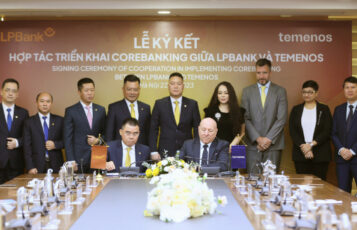Apri 27, 2021 – LienVietPostBank: We choose and stick to our own way, CEO says
27/04/2021“LienVietPostBank will continue to focus on retail banking on the basis of exploiting its network strengths, especially in rural and remote areas where people have little opportunity to access financial and banking services, easily affected by “black credit”.

Mr. Pham Doan Son, Standing Vice Chairman of LienViePostBank’s Board of Directors cum CEO said.
Retail banking has always been considered a core activity of the banking system, however, Successful people always have their own way. What do you think?
The current reality shows that the level of access to financial services in Vietnam is still low compared to the general level of other countries, the financial technical infrastructure system is mainly concentrated in the centers, big cities and have not reached the difficult and backward areas. Meanwhile, according to the results of the Population and Housing Census published by the General Statistics Office in 2020, the rural population reached more than 63 million people, accounting for 65.6% of the total population of the country with more than 96 million people.
Recently, the Government has approved the National Comprehensive Financial Strategy to 2025, oriented to 2030 with some specific targets such as at least 80% of adults with trading accounts at banks or other authorized institutions; at least 50% of communes have financial service provision points; credit balance for agricultural and rural development reached 25% on the total credit balance for the economy.
In order for financial service products to reach a large number of people, especially in areas with low socio-economic development, where “black credit” is still prevalent, the network should be expanded. The Bank’s “physical” transaction points will remain the route that LienVietPostBank chooses.
At the previous General Meeting of Shareholders of LienVietPostBank, you once said “in order to implement the retail banking strategy, LienVietPostBank must “cover” transaction offices to communes and districts across the country”. Can you tell us about the progress of this plan up to now?
In fact, most of banks’ transaction points are still concentrated in big cities, where densely populated with modern technology and economy. Meanwhile, in rural and remote areas, where retail space is still very large, banking transaction points are still sparse. Banks are quite hesitant to open new transaction points in these areas because investment costs are high and mainly small customers, so the time to recover capital is slower than transaction points in urban areas. That imbalance has created a large void in rural areas where people are also in desperate need of capital but difficult to access banking services. Looking at that situation, over the years we have focused on expanding the banking network in rural and remote areas on the basis of upgrading postal transaction offices in districts into banking transaction offices. The upgrade process has been gradually completed to promote efficiency, creating a retail advantage for LienVietPostBank. In the coming time, we will continue to upgrade the post offices in the remaining districts to the Bank’s transaction offices so that people in those areas can access healthy financial services; contribute positively to the improvement of economic life, modernize agriculture and rural areas and join hands to repel “black credit”.
Although still in the process of realizing the goal of expanding its network in rural areas, LienVietPostBank is still promoting its online transaction system. Is the Bank in “money burning”?
In my opinion, in the current digital economy, the combination of developing a network of physical transaction points with an online transaction system, specifically here is a digital bank – LienViet24h is a model considered suitable for the current Vietnamese market.
We all know that, with 65% of the population living in rural areas, people’s level of access to and knowledge of using digital services is still limited, they need time to receive instruction, training to use. Therefore, it takes a certain amount of time to popularize and widely develop digital banking products and services. Seizing this opportunity and challenge, LienVietPostBank chose a strategy to catch the trend, both developing the physical network and focusing on developing digital banking. Through a network of transaction points located in all district-level administrative units across the country, we provide guidance, advice and direct support to customers, increasing accessibility to people in using digital technology products more easily and cost-effectively.
In 2021, we set a target of 1 million more subscribers and by 2025, about 5 million subscribers of LienViet24h. LienVietPostBank’s foundation of assets, network, people, technology and services are all ready for the orientation of LienVietPostBank’s leading retail banking group in Vietnam, which was established many years ago.
What I want to emphasize is that LienVietPostBank will definitely “go” in parallel: online adds value to offline, offline supports online. With a nationwide network of 556 branches/transaction offices and 613 post offices, technology and digital transformation are the “shortcuts” to help LienVietPostBank reduce costs and optimize the operation process, improve labor productivity throughout the system. On the contrary, network advantage becomes a direct and widespread flow in consulting and implementing digital banking services.
Investing in technology is an effective investment in the future and investment always takes a certain amount of time, but I believe that when we go in the right direction and persevere, we will surely achieve great success in the future.
Despite the Covid epidemic, the Bank’s business results were still positive; bank stocks after moving to the floor increased sharply; LienVietPostBank is in the TOP Bank with the fastest growth in sales of insurance through banks (Bancassurance) in the market. With those achievements, is this perhaps good news for shareholders?
Since 2016, LienVietPostBank has signed an exclusive insurance business cooperation contract with Dai-ichi Life Vietnam for a period of 5 years and started to operate in February 2017. At the beginning, the Bank chose Refer model – introducing customers to Dai-ichi’s insurance advisors at sales advisory branches/transaction offices. After a while for the system to get used to the new service, combined with intensive and professional training courses, LienVietPostBank has gradually shifted to the direct insurance sales model and from January 2021 we applied this model throughout the Bank’s system. LienVietPostBank’s employees are trained and guided to advise customers directly without the support of Dai-ichi’s personnel.
Up to this point, I can confirm that this is a right decision, contributing to placing LienVietPostBank in the TOP Bank with the fastest growth rate of Bancassurance with first-year actual premium revenue (FYP), ranked 9th in the whole market. This year is also the last year of exclusive cooperation with Dai-ichi Life Vietnam, we are choosing the right insurance partner to carry out the exclusive contract in the near future.
LPB shares traded on HOSE are one of the important milestones for our Bank because from the very first day of establishment, the founding shareholders have been looking forward to the day when the Bank’s shares will be listed on the leading high standard stock exchange in Vietnam. When listing shares on HoSE, our biggest goal is to make the Bank’s information more public and transparent to shareholders and investors. Through fact-checking, the decision to switch to HoSE with higher listing standards, more transparency, concentration of larger-cap stocks, higher liquidity, etc. has helped raise the brand and value of the Bank and attracted great attention from domestic and international investors.
Due to the improved liquidity of the shares, it benefits both the Bank and shareholders, contributing to the increase in the value of the shares. Besides, the Bank has many opportunities to approach and select foreign investors with good financial potential, experience and increase the ability to mobilize capital to meet future development needs.
As you mentioned above, LienVietPostBank becoming a retail bank has been a strategy for over 10 years, will this strategy change in the next 10 years?
LienVietPostBank is still loyal to its retail strategy. In order to maintain that, we will continue to strengthen and improve the quality of human resources from now on and even in the following years, invest in technology, accelerate the process of digitization and digital transformation, continue to expand the network, focus on building and developing products suitable for each customer segment and each location. These are the core foundations for LienVietPostBank’s sustainable development in the future.





